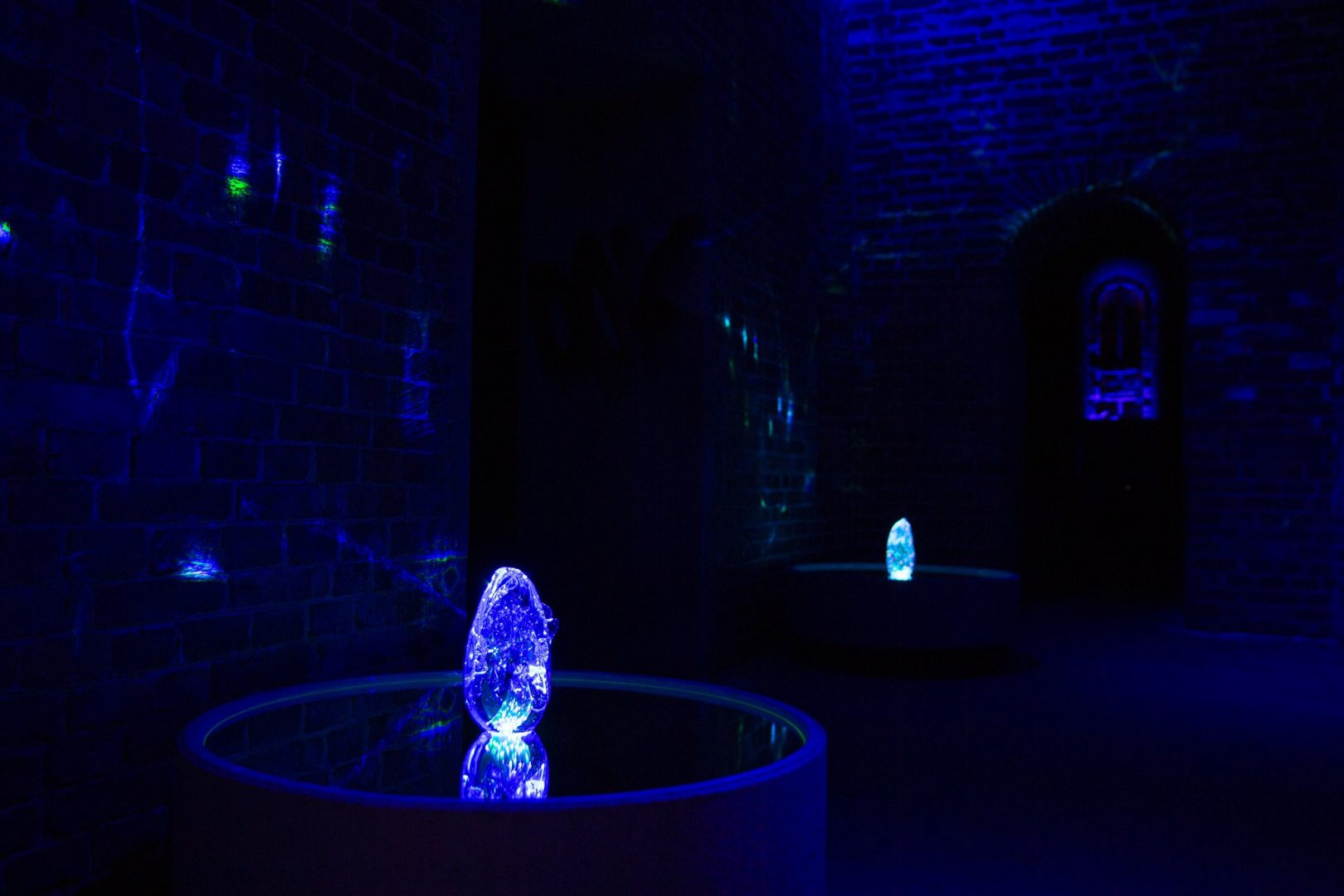Emilija Škarnulytė is a Lithuanian-born nomadic artist and filmmaker. Working between the realms of the documentary and the imaginary, Škarnulytė makes films and immersive installations exploring deep time and invisible structures. Her topics range from the cosmic and geological to the ecological and political.
Helsinki Biennial 2023 presented a new commissioned film installation, Hypoxia, which refers to a condition of oxygen starvation. Drawing inspiration from the Baltic Sea, the piece is a meditation on extinction, future archaeology, and deep time, speculating on the contemporary scientific conditions and technologies related to deep-sea mining and ocean mapping (LIDAR, elaborated Landsat landscape data, and polarimetry) from the imaginary perspective of a future archaeologist.
By examining the ocean basin from what she calls an “alien archaeology perspective”, Škarnulytė aims to reconstruct mythologies and beliefs of the past and present, looking at them from the vantage point of the future.
The film weaves together various subjects: the Baltic Sea anomaly, a spacecraft that reportedly lies at the bottom of the Baltic Sea; the anthropogenic phenomenon of hypoxia, i.e., oxygen depletion that causes dead zones to appear in seas; and the Lithuanian myth of the sea goddess Jūratė, whose amber palace beneath the waves was destroyed because of the heroine’s dalliance with a human. Myth meets science and science fiction beneath the waves.
Hypoxia. Dead zones form as oxygen levels are depleted. Suffocation is becoming the new normal. The sea surface is ‘boiling’ with methane bubbles. Our political choices have produced after-shocks such as the Nord Stream explosion, causing the worst natural gas leak ever. Remnants of our defence and health industries lie at the bottom of the sea – in the form of Cold War myths and radioactive waste, from which it will take decades to recover. Humans have heaped a massive burden of hazards upon the environment, causing hypoxia that is devastating for the sea.
Hypoxia weaves together disparate subjects of narrative to comment on the hard-to-fathom findings that are prevalent everywhere in our contemporary reality. The first subject is the ‘Baltic Sea Anomaly’, a speculative sci-fi scenario of what lies at the bottom of this deadly and polluted body of water. The second strand of narrative harks back to ancient myth. The chief deity in Lithuanian mythology, the thunder god Perkūnas, had a daughter named Jūratė who lived in an amber palace beneath the Baltic Sea. Her love affair with a human caused her father to smash the palace, and the amber washed up on Lithuanian shores is still widely known as ‘Jūratė’s Tears’. In reality, these are the captured carbon relics of an ancient forest submerged beneath the waves long ago.
Our myths have long been stand-ins for natural phenomena and human desire, our dreams and stories mixing with the forces and landscapes that surround us. As we destroy this world with all the reckless bravado our ascendant species can muster, these myths come back with the vengeance of angry gods through ecological collapse. Measured and traced with the most modern of instruments, our very human and very abusive relationship with the Baltic Sea invites these ancient deities to return with new stories of divine retribution and freshly wept tears.
Emilija Škarnulytė

Emilija Skarnulyte, Hypoxia, 2023, Helsinki Biennial 12.6.-17.9.2023, Vallisaari, Helsinki, Photo: © HAM/Helsinki Biennial/Kirsi Halkola

Emilija Skarnulyte, Hypoxia, 2023, Helsinki Biennial 12.6.-17.9.2023, Vallisaari, Helsinki, Photo: © HAM/Helsinki Biennial/Sonja Hyytiäinen
Co-Commissioned by Helsinki Biennial and TBA21–Academy, produced by HAM Helsinki Art Museum/Helsinki Biennial 2023.
In 2022, Škarnulytė participated in the group exhibition Penumbra organized by Fondazione In Between Art Film at the 59th Venice Biennale. Škarnulytė represented Lithuania at the XXII Triennale di Milano and her work featured in the Baltic Pavilion at the 2018 Venice Biennale of Architecture. With solo exhibitions at Tate Modern (2021), Kunsthaus Pasquart (2021), Den Frie (2021), National Gallery of Art in Vilnius (2021), CAC (2015) and Kunstlerhaus Bethanien (2017), she has participated in group shows at Ballroom Marfa, Seoul Museum of Art, Kadist Foundation, and the First Riga Biennial.
Her films are represented in the IFA, Kadist Foundation and Centre Pompidou collections and have been screened at the Serpentine Gallery, UK, Centre Pompidou, France, and the Museum of Modern Art, New York and at numerous film festivals including in Visions du Réel, HOT DOCS, Rotterdam, Busan, and Oberhausen.
Škarnulytė is the winner of the 2019 Future Generation Art Prize, and she has also received numerous other prizes including the Kino der Kunst Project Award, Munich (2017); Spare Bank Foundation DNB Artist Award (2017), and the National Lithuanian Art Prize for Young Artists (2016). She was recently nominated as one the candidates for the Ars Fennica art award 2023.
Emilija Skarnulyte
Hypoxia
2023
film installation
Written and directed by Emilija Škarnulytė
DOP: Derek Spencer Howard, Emilija Škarnulytė
Editor: Vytautas Tinteris
Sound: Jokūbas Čižikas
CGI: Gregory Blunt
Production: Mirror Matter Productions
Exhibition Architect: Linas Lapinskas
Thank you: Andrius Šiaulys; Arūnas Gelūnas; Baltic Sea Nature & Heritage Protection Association; Egidijus Pavilonis; Elena Pranckėnaitė; Eric Cordes; Erik Vojevodin; International Dialogue on Underwater Munitions; Jeremy McKane; Juan Raya Rodríguez; Klaipėda University Underwater Research Centre; Klaipėda University Sea Research Institute; Linas Duoblys; Nerijus Blažauskas; Palanga Amber Museum; Pisces VI Submarine; Sabine Kerkau; Scott Waters; Spanish Institute of Oceanography (IEO); TBA21; Terrance P. Long; Zita Rasuolė Gasiūnaitė; Schmidt Ocean Institute
Co-Commissioned by Helsinki Biennial and TBA21–Academy, produced by HAM Helsinki Art Museum/Helsinki Biennial 2023